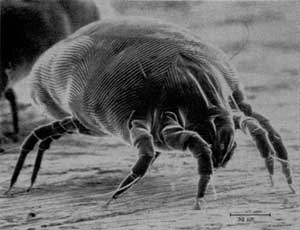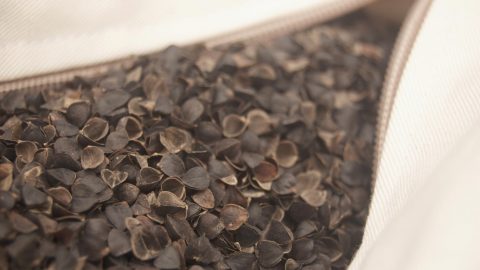55% of the U.S. population tests positive to one or more allergens. Allergies are such a pain in America’s ass that the allergy treatment and management market generates annual revenues in excess of 6 billion dollars!
Pillow manufacturers want some of that wonderful cash, so they frequently market their products as being hypoallergenic. These claims really resonate with consumers. If you’ve experienced any inconvenience related to allergies, a hypoallergenic pillow can sound like a smart purchase if it can prevent potential allergic reactions.
So many hypoallergenic pillow choices…
At the present time, 10% of the bed pillows available at Amazon.com use the term “hypoallergenic” in their descriptions. In fact, every popular type of pillow claims to be hypoallergenic including: down pillows, memory foam pillows, poly foam pillows, buckwheat pillows, microbead pillows, latex pillows, water pillows, kapok pillows and millet hull pillows.
The fact that all these different pillows claim to have hypoallergenic qualities suggests that there’s a little bullshit in the air.
What is a hypoallergenic pillow anyway?
Unfortunately calling any product hypoallergenic is a relatively hollow claim. That’s because there is no regulation in the United States that defines or governs the use of the term. Consequently hypoallergenic pillows can be advertised with impunity. Pillows that are no better or worse at resisting allergens are labeled hypoallergenic without consequence.
A medical dictionary provides a somewhat vague definition:
“Hypoallergenic” – Adjective
A term applied to a preparation in which every possible care has been taken in formulation and production to ensure minimum instance of allergic reactions. Blakiston’s Medical Dictionary
Has “every possible care been taken,” to prevent allergic reactions in these hypoallergenic products?
Some hypoallergenic claims seem more legitimate than others.
Most hypoallergenic pillow’s descriptions are rather cryptic and vague. On the other hand, some explain in detail the supposed hypoallergenic benefit and how it’s achieved. They cite specific manufacturing techniques or have detailed scientific explanations that can be rather convincing. For example, down pillow filling (often unfairly characterized as allergen-prone) is sometimes described as having been washed to remove the goose dander.
Unfortunately, no comprehensive study exists that shows any single type of pillow being more (or less) effective at preventing allergic reactions.
The scientific studies that compare hypoallergenic bedding products show contradictory and inconclusive results. Get this—allergists at Ohio State University found that some so-called hypoallergenic pillows might actually be less effective than traditional feather pillows.
“… side-by-side tests of pillow types show that so-called “anti-allergy” pillows can cause more allergic reactions than feather pillows. It is a widely held belief that feather pillows cause allergic reactions, but studies show that the porous materials used in some synthetic pillows can actually retain more mold and dust mites than feather pillows.” –LiveScience.com
A lack of consistent evidence makes determining the best type of hypoallergenic pillow difficult. Being that the case, I recommend you simply tune out the confusing hypoallergenic noise.
Not coincidentally, the materials used in the construction of the most popular pillow types are all relatively benign. Allergies to the materials used in pillows do exist of course, but they are rare. If you’re allergic to something, you’re allergic! Treating it with a special process or wash that supposedly makes it hypoallergenic won’t change its potential to annoy the hell out of you!

I’ll poop in your bed!
Dust mites are the true allergy menace and no pillow type is immune to them.
Dust mites are one of the top five most common allergens. The effects of a dust mite allergy are very similar to a pollen allergy except that the symptoms occur year round instead of just seasonally.
“Dust mites are microscopic creatures, about 0.4 millimeters in length, that feast on flakes of human skin. Their feces contains a substance called DerP1, a very potent allergen. People who are allergic to dust mites may have asthmalike symptoms, eczema or chronic sinus problems.” NYTimes.com
If you’re experiencing an allergic reaction to a pillow that you’ve been using for awhile, chances are you’re allergic to dust mites, not the pillow itself. That said, while dust mite allergies are common, it’s not always obvious. This ambiguity benefits hypoallergenic pillow manufacturers. Consumer’s uncertainty about allergen facts makes their broad claims of hypoallergenic benefits look very appealing.
You might be allergic to dust mites if you experience any of the following symptoms:
- headaches,
- congestion,
- sneezing in the morning, or
- scratchy eyes.
To be sure, you can take an allergy test. Most insurers will cover the cost and they take only about an hour to complete.
Hypoallergenic pillows are not immune to dust mites.
All pillows, with use, will accumulate particles of organic material from your body that dust mites crave. Every night you sleep on your pillow, you leave behind delicious dead skin for dust mites and their families!
What can you do to avoid dust mites?
- Lower the humidity in your home. Dust mites only appear in humid environments. You’re not likely to have dust mites if your home is kept with a relative humidity of less than 50%.
- Use dust mite covers. These are generally vinyl or plastic covers that prevent foreign materials from getting inside your pillow. While most experts recommend them, they are still somewhat controversial. An unfortunate drawback to dust mite covers is that they will prevent air from moving freely through your pillow. This can result in it retaining heat and being uncomfortable.
- Take extra care to keep your pillows clean. Wash your pillowcase frequently and your pillow too, if possible.
Should I be concerned about dust mites if I’m not allergic?
I’ve read some pretty shocking claims about pillows full of pounds of dust mite corpses and their feces. The fact is these stories are exaggerated and dust mites aren’t something most of us should be concerned about. They will not take up residence in your bedding unless the circumstances are just right. Even a few of them do, they’re not going to cause any trouble unless you’re allergic to them.
Ultimately, you don’t need a so-called hypoallergenic pillow.
Instead of sleeping on a pillow that is unnecessary or even counter-productive, just apply this simple logic:
- Choose a pillow that’s comfortable and suited for your sleeping position.
- If you’re allergic to down or some other specific material, try a pillow made with something else.
- If you’re allergic to dust mites, take precautions to prevent them from .
Don’t believe any claim that a pillow is capable of preventing allergic reactions. In fact, all pillows can accumulate mold, bacteria and dust mites. Unfortunately allergens are everywhere. No pillow has a magical force field that can protect it from being exposed to them.
A note specifically about buckwheat pillows.
In case you hadn’t already guessed, we make and sell buckwheat pillows. We love them because we believe they’re the best type of pillow, but they don’t have any magical anti-allergy powers. Many of our competitors describe their products as being hypoallergenic. There’s no evidence to suggest they’re any better than any other pillow type at preventing allergic reactions. We do not advertise or describe our products as being hypoallergenic.



